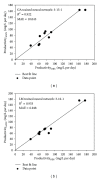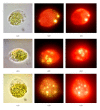Comparative analyses of response surface methodology and artificial neural network on medium optimization for Tetraselmis sp. FTC209 grown under mixotrophic condition
- PMID: 24109209
- PMCID: PMC3784237
- DOI: 10.1155/2013/948940
Comparative analyses of response surface methodology and artificial neural network on medium optimization for Tetraselmis sp. FTC209 grown under mixotrophic condition
Abstract
Mixotrophic metabolism was evaluated as an option to augment the growth and lipid production of marine microalga Tetraselmis sp. FTC 209. In this study, a five-level three-factor central composite design (CCD) was implemented in order to enrich the W-30 algal growth medium. Response surface methodology (RSM) was employed to model the effect of three medium variables, that is, glucose (organic C source), NaNO3 (primary N source), and yeast extract (supplementary N, amino acids, and vitamins) on biomass concentration, X(max), and lipid yield, P(max)/X(max). RSM capability was also weighed against an artificial neural network (ANN) approach for predicting a composition that would result in maximum lipid productivity, Pr(lipid). A quadratic regression from RSM and a Levenberg-Marquardt trained ANN network composed of 10 hidden neurons eventually produced comparable results, albeit ANN formulation was observed to yield higher values of response outputs. Finalized glucose (24.05 g/L), NaNO3 (4.70 g/L), and yeast extract (0.93 g/L) concentration, affected an increase of X(max) to 12.38 g/L and lipid a accumulation of 195.77 mg/g dcw. This contributed to a lipid productivity of 173.11 mg/L per day in the course of two-week cultivation.
Figures






References
-
- Azma M, Mohamed MS, Mohamad R, Rahim RA, Ariff AB. Improvement of medium composition for heterotrophic cultivation of green microalgae, Tetraselmis suecica, using response surface methodology. Biochemical Engineering Journal. 2011;53(2):187–195.
-
- Chisti Y. Biodiesel from microalgae. Biotechnology Advances. 2007;25(3):294–306. - PubMed
-
- Huang G, Chen F, Wei D, Zhang X, Chen G. Biodiesel production by microalgal biotechnology. Applied Energy. 2010;87(1):38–46.
-
- Gladue RM, Maxey JE. Microalgal feeds for aquaculture. Journal of Applied Phycology. 1994;6(2):131–141.
Publication types
MeSH terms
Substances
LinkOut - more resources
Full Text Sources
Other Literature Sources
Research Materials

